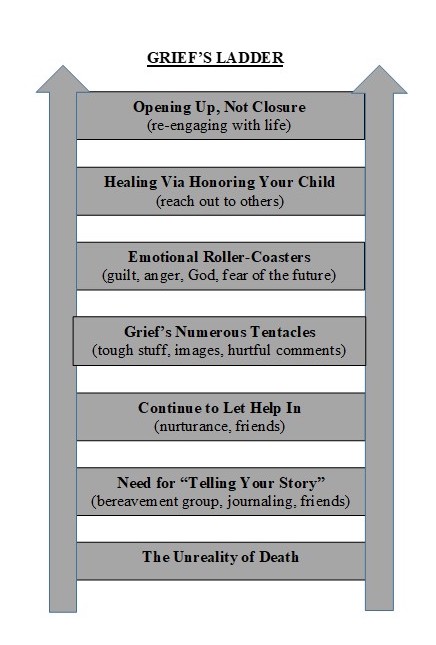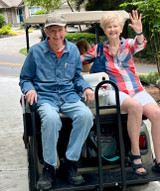Grief’s Ladder
The Uncharted Journey of Child Loss
On January 4, 1997 Carolyn and I lost our 17-year-old son, Andy, in a car accident. Two weeks later, one of the first suggestions taken from a child-loss bereavement group was that I journal my thoughts and feelings as a way to deal with my grief, thus capturing both behaviors and thinking as they were happening, effectively cutting through the fog of memory loss caused by Andy’s death. I have consistently journaled my thoughts ever since Andy’s loss, together with continuing to attend and then assist in a child-loss bereavement group. During these ensuing years I read voraciously on loss to better understand my emotions and how to deal with grief’s all-encompassing tentacles.
The journal writing, talking, and insights gained from both interacting with and reading about bereaved parents would have all remained a somewhat disparate set of thoughts had I not tried to sort through the various pieces of grief’s mosaic via my memoir, Grief’s Ladder (a son’s death and a father’s healing promise). Over the many years dealing with Andy’s loss it is crystal clear that there are two major pieces bereaved parents must sort out: the grief itself and figuring out how to rebuild a meaningful life. The hopeful message of this memoir stems from a promise made to Andy as my wife and I viewed his body in the hospital’s emergency room. I still don’t know what compelled me at that moment to promise Andy that I would “do some of the good you would have done had you lived longer” - a promise that has so meaningfully impacted my life.
First, the grief aspect of Grief’s Ladder. Current research points to parental grief differing from other deaths (parents, siblings, relatives, friends) in three key areas: it is intensified, broadened in scope, and most importantly, lengthened. The “intensification” of parental grief is reflected in on-going emotional turmoil around guilt, anger, God, and a pervasive fear of future tragedy involving their family. Grief’s “broadening” of scope plays out with concern over lack of sibling support, strains in spousal connection, male/female grieving differences, and an all too often distancing of friends and relatives. But the biggest difference child loss has with other types of death is its “lengthening” of the grief process. All too often I’ve heard bereaved parents question why their pain remains so intense despite months and years having passed; similarly, friends question why the parents haven’t “moved on,” why “closure” hasn’t been achieved after a few months have passed.
Each of the multitude of factors associated with the intensification, broadening, and lengthening are explored in the bottom five rungs of Grief’s Ladder, detailing how they interact to shape the tapestry of our grief journey. (See Figure 1.) Each rung needs an answer to your specific situation: “What actions can I take to feel better, how can I deal with the varied issues inherent in that rung?” The all-too-similar experiences of other bereaved parents help clarify some answers. My bereavement group experience exemplifies the importance of sharing and learning from our varied difficulties. While each parent’s journey through grief is uniquely theirs, we nonetheless share so many commonalities. We are more alike than different.
GRIEF’S LADDER

Figure 1
Importantly, as I dealt with my grieving I began laying the groundwork for building a new and different space to hold our child in my life. This is where my promise to Andy took root. It was in taking actions that honored Andy’s memory, sporadically at first, that I began building a foundation for eventually grasping those upper two rungs. Over time the cumulative effect of actions honoring the memory of your child allows a firm hold on re-engaging with life. Now I see more clearly than ever that the “other side of grief” is not the life I had before the loss. It can be a good life, but it’s not the same life. Once we’ve largely journeyed through grief, we need some meaning that holds together our “new life” while yet retaining a loving connection to the child we miss so much.
These top two rungs explore how integration of your child’s memory into how you lead your life can be a key to healing. Simply being able to reach a final stage where you “accept the loss” is not what we want – most of us can never accept “closure” as a final answer. The key is figuring out how to maintain that connection with your child, not as an obsession but as a focus for allowing some good to come from your loss. How can you find ways to live with your loss while still holding close to your heart the child you miss so deeply? For me, and myriad others I have known or read about, trying to make something positive come out of Andy’s loss has been the answer, my promise to Andy.
I hope reading the message of this memoir will help in your journey toward regaining life’s purpose, keeping your child always by your side. When a child dies, that life is left unfinished; our children’s deaths left us with their unfinished business. Who better than the parents to complete their child’s unfinished business? My promise to Andy to do some of the good he would have done brought purpose to both his life and mine.
Obviously, trying to condense an entire memoir into a short article leaves much unsaid. I hope to follow this article with future entries in Grief Digest to explore the complexities of each rung, complexities that distinguish child loss from other types of loss. My deepest wish is that some of you who read the entire memoir will be assisted in your grief journey. If so, some of my promise to Andy will be fulfilled.
(Journal entry from November 14, 2009) Been over 12 years since Andy’s loss. Maybe over that time I’ve come to believe that grief has the potential to strengthen you. Somewhere I read that grief will continue to control you until you make a stand, and then it has the capability of being both a teacher and a guardian of your well-being. Exploring questions around Andy’s loss and what constitutes a meaningful life has eased my pain. Perhaps this comes when you ask the question, “Why did my child live?” rather than continually grieving the question of “Why did my child die?”
(Any profits from my memoir will be used in furtherance of my promise to Andy.)
About the Author
I am married (51 years) and the father of three boys, one of whom is deceased. My bereavement credentials include 15+ years assisting in a child-loss bereavement group, extensive research on grief and child loss, and the writing of a recently published (2019) memoir: Grief’s Ladder: A Son’s Death and a Father’s Healing Promise. My memoir evolved over two decades from journal entries (over 6000), extensive research, and invaluable generalized learning from my child-loss bereavement attendance. My professional background includes teaching and a 30-year career in advertising, marketing, and market research.




